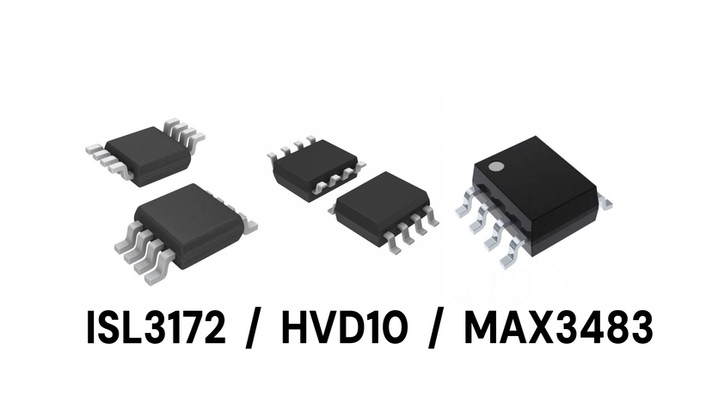
Introduction
In industrial automation, building control, and embedded communication systems, RS-485 and RS-422 buses remain mainstream industrial standards thanks to their strong noise immunity, long transmission distance, and simple wiring.
However, transceivers from different manufacturers vary significantly in data rate, power consumption, temperature range, and protection features. Without careful evaluation at the selection stage, designers may encounter signal distortion, communication failures, or even device incompatibility.
This guide compares three commonly used models — ISL3172EIUZ-T, SN65HVD10DR, and MAX3483AEASA+ — and provides insights into application requirements, design considerations, and substitution recommendations to help engineers choose the most suitable solution.
Parameter Comparison
ISL3172EIUZ-T | SN65HVD10DR | MAX3483AEASA+ | |
Manufacturer | Renesas Electronics | Texas Instruments | Maxim Integrated |
Communication Standard | RS-422 / RS-485 | RS-422 / RS-485 | RS-422 / RS-485 |
Driver / Receiver Channels | 1 / 1 | 1 / 1 | 1 / 1 |
Maximum Data Rate | 250 kbps | 32 Mbps | 10 Mbps |
Supply Voltage Range | 3.0 V ~ 3.6 V | 3.0 V ~ 3.6 V | 3.0 V ~ 3.6 V |
Operating Temperature Range | −40 °C ~ +85 °C | −40 °C ~ +85 °C | −40 °C ~ +125 °C |
ESD Protection | ±15 kV (IEC 61000-4-2) | ±15 kV (IEC 61000-4-2) | ±15 kV (IEC 61000-4-2) |
Package Type | 8-MSOP | 8-SOIC | 8-SOIC |
Key Features | Low-Power & Robust Communication | High-Speed & Real-Time Control | Wide-Temperature & High Reliability |
Application Analysis
ISL3172EIUZ-T (Renesas)
Designed for low-power, long-distance communication in sensor networks, PLC slaves, and remote data acquisition modules.
The low-power architecture combined with an internal fail-safe mechanism ensures stable logic levels during idle or interference conditions.
Its slew-rate-limited output minimizes EMI noise, improving signal integrity over long cables.
Typical Applications: Environmental monitoring nodes, building automation, industrial data acquisition modules.
SN65HVD10DR (Texas Instruments)
Targeted at high-speed and real-time control systems such as servo drives, motion controllers, and industrial Ethernet bridges.
With a data rate up to 32 Mbps and a −7 V to +12 V common-mode range, it ensures signal integrity even in harsh industrial EMI environments.
Built-in short-circuit and thermal shutdown protection provides enhanced reliability for continuous operation.
Typical Applications: Servo control, PLC backbone communication, robotic control networks.
MAX3483AEASA+ (Maxim Integrated)
Ideal for wide-temperature and high-reliability environments, including energy monitoring, outdoor automation terminals, traffic systems, and security networks.
Operating across −40 °C to +125 °C with ±15 kV ESD protection, it maintains stable performance under extreme conditions.
A 10 Mbps medium-speed design provides an optimal balance between efficiency and robustness.
Typical Applications: Energy management systems, building control, unattended monitoring equipment.
Design Considerations
Data Rate and Cable Length Matching
High-speed transmission requires proper impedance control and line termination. A 120-Ω termination resistor at both ends of the bus is recommended to reduce reflections.
Fail-Safe Logic Differences
Manufacturers define idle-bus logic levels differently. Verify receiver output logic before replacing transceivers.
ESD and Thermal Protection
Although rated for ±15 kV ESD, additional TVS diodes and common-mode chokes are recommended in high-static or surge environments.
Common-Mode Voltage and Ground Design
Keep ground potential differences within −7 V to +12 V. For multi-ground systems, consider using galvanically isolated transceivers.
Power Management
In low-power systems, use the DE/RE pins to disable the driver/receiver during standby to minimize current consumption.
Substitution & Migration Recommendations
ISL3172 → SN65HVD10
Recommended when higher data rates or lower latency are required. Pin configuration and voltage compatibility are similar.
ISL3172 → MAX3483A
Suitable for high-temperature or long-duration operation environments requiring enhanced robustness.
SN65HVD10 ↔ MAX3483A
Comparable performance range: SN65HVD10 for speed-critical systems, MAX3483A for reliability-oriented designs.
In RS-485/RS-422 communication design, data rate, power efficiency, and environmental tolerance are the key criteria for device selection.
Low-speed and power-sensitive systems benefit from low-power, slew-rate-limited transceivers.
High-speed, real-time control networks require high-bandwidth, low-latency devices.
High-temperature or high-noise environments demand wide-temperature, high-reliability transceivers with strong ESD protection.
Engineers should evaluate line length, termination strategy, and EMC performance during prototyping to ensure long-term communication stability.
WIN SOURCE provides a wide range of RS-485/RS-422 transceivers with global brands including Renesas, Texas Instruments, and Analog Devices. Visit WIN SOURCE to check real-time inventory and lead times, ensuring a stable and reliable component supply for both prototyping and mass production.
©2025 Win Source Electronics. All rights reserved. This content is protected by copyright and may not be reproduced, distributed, transmitted, cached or otherwise used, except with the prior written permission of Win Source Electronics.

COMMENTS